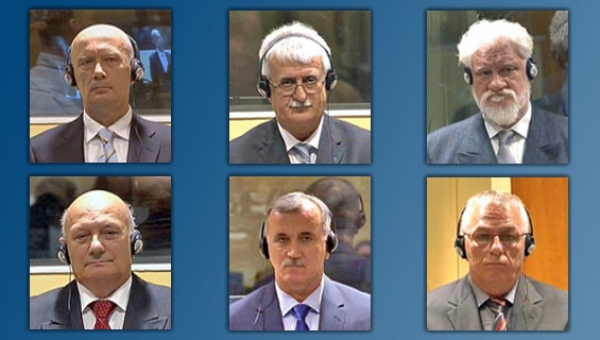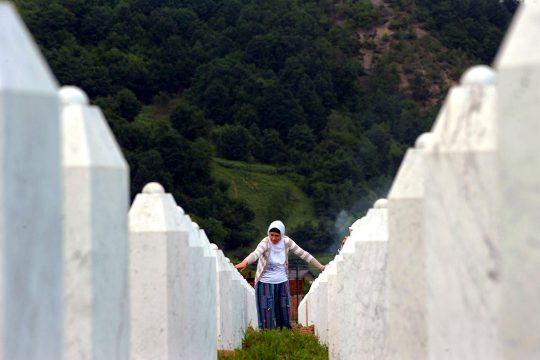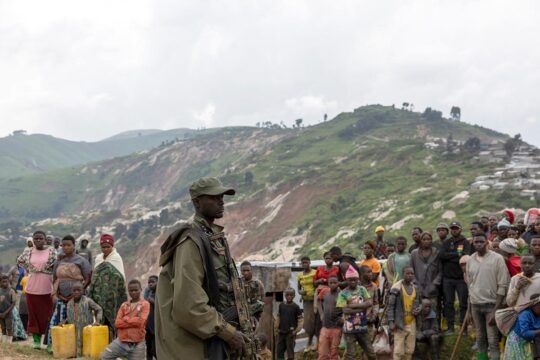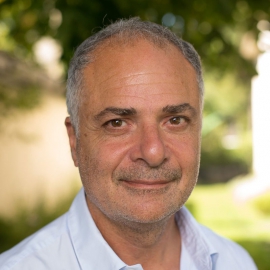Latest UN judges uphold 25-year jail term on Bosnian Croat leader Prlic
On November 29, the International Criminal Tribunal for the former Yugoslavia (ICTY) is to hand down its last judgment before closing its doors in a few weeks’ time. The six accused were already tried by the lower court in 2013 and given prison sentences of 10 to 25 years for 26 counts of crimes against humanity and war crimes, including persecution, murder, rape and sexual violence, forced displacement and inhuman acts.
These six former top leaders of the self-proclaimed Croatian Republic of Herzeg-Bosnia are now being judged on appeal. The most prominent among them is Jadranko Prlic, a brilliant economist and former professor, who was invited to the United States before becoming Prime Minister of this republic that was never recognized. After the Dayton accords that ended the war in Bosnia-Herzegovina, he was even Foreign Minister of that country from 1996 to 2001. He and his five co-defendants are accused of having tried during the 1993 war to purge Muslims definitively from the Herzegovina region that they controlled with their armed HVO militia and having set up a network of sinister detention centres.
The verdict of the ICTY Appeals Chamber has special resonance for me because in September 1993, as a journalist for Libération and the Nouveau Quotidien, I went with delegates of the International Committee of the Red Cross (ICRC) into Dretelj camp, one of the worst detention camps in the former Yugoslavia.
Dretelj camp, which figures largely in the ICTY judgment of 2013, was administered by the HVO. Under pressure from the US, Germany and the Vatican, the Croatian government in Zagreb got agreement that the ICRC could free some of the 1,000-2,000 prisoners in Dretelj camp. That was the context in which I accompanied an ICRC team on September 19, 1993 and the following days. Those were terrible days. The ICRC doctor had nightmares that he was Mengele, obliged to proceed with selecting people and deciding who would be freed, and who would be condemned to remain in this deadly camp.
I remember how we brought scales and measuring gear to weigh and measure the prisoners in the camp courtyard, to identify the weakest and ask for their liberation. Most of the prisoners were crushed into a hangar, on top of each other, plunged into an almost permanent semi-darkness. It was during those days that I understood how a civil war can break the fabric of society. Guards and prisoners had sometimes been school friends, played together and grown up together. One of the camp officials knew “prisoners of worth” – often families abroad who might be ready to pay – and was hoping to negotiate money in exchange for a promise of freedom.
The ICTY’s 2013 judgment in the Prlic case tells of the over-population, hunger, thirst, humiliation and cruel treatment which led to the deaths of two prisoners, and of three others killed when military police shot randomly into the hangar where the prisoners were. The judgment also records how prisoners who did not eat their meagre rations fast enough were forced to lie on burning tarmac and roll on it without their shirts. But the judgment, in its cold and clinical description, cannot convey the atmosphere of fear and death that reigned in that camp, the terrible smell of the hangar, the overcrowding, the emaciated bodies, as we listened to distant gunshots.
Twenty-four years later, international justice is handing down its final verdict. During the first trial from 2006 to 2013, the Court admitted 10,000 pieces of evidence, heard more than 200 witnesses and produced a judgment of 2,629 pages. This mobilization of resources reflects all the ambition but also all the ambiguity of international criminal justice. The war and the atrocities committed in the camps need to be known. But who will read these 2,629 pages written in judicial language? And who will read this appeals judgment? How can we move from recognition by a few experts to recognition by the public at large? The hope of those who dreamed of creating the first international criminal tribunal was that it would contribute to peace and reconciliation. The guns fell silent in Bosnia-Herzegovina in 1995 after the Dayton accords. But it is still a cold peace, conflict over the past continues and nationalism is thriving in Bosnia, Croatia, Serbia and Kosovo.
Extracts from Pierre Hazan article published October 19, 1993 in Libération and the Nouveau Quotidien
Dretejl camp (Herzegovina, territory under Croat control), September 19. Four land-cruisers draw up in front of one of the most terrifying prisons of the Bosnian conflict. Waving their badges, about a dozen ICRC delegates get out of the vehicles and go into this former Yugoslav army barracks.
Just back from the front with their Kalashnikovs still smoking, Croat HVO soldiers watch with stony eyes as they pass. In the prison courtyard a few rickety cars, three toilets open to the wind, barbed wire and a sign saying “Beware of mines”: this is Dretejl. Beat, the ICRC doctor, is leading the operation. He has just turned down a prestigious post in the Basel chemicals industry to return to the idealism of his youth, but his mission today is making his stomach churn. He must select the 500 weakest prisoners to be freed early.
Alija, like the 1,500 others confined in a dark tunnel with a rancid smell, does not know that his fate is in the balance. After 50 days in detention, he weighs 50 kilos for a height of 1.78 metres. Stumbling, blinking their eyes in the light, Alija and his companions emerge from their hole. They obey instructions without any reaction, removing shoes, showing prisoner cards issued by the ICRC, getting on the scales and allowing their height to be measured: Izet 1.72 metres, 54 kilos; Hasan 1.80 metres, 59 kilos; Souad, 1.76 metres, 55 kilos, and so on. Most of them have lost 20-30 kilos, sometimes even more.
To identify the weakest in this cohort of misery, Beat has opted for Body Mass Index: the weight of each detainee minus two kilos of clothing, divided by the square of the body height. Results show that 6.7% are near death (BMI below 16), 55% have severe malnutrition (BMI between 16 and 20) and the rest are just above.
Mostar (territory under Croat control), September 20. It has been a week since an ICRC employee and her mother were taken away by soldiers, and since then there has been no trace. Against a background of gunfire and shelling one of her colleagues, also Muslim, explains that “fear comes with the night”. She herself has prepared a small bag in case she is disappeared, taken away by the Croat army or, even worse, by “irregulars”.
Dretejl camp, September 21. It is the day for the release of the 500 prisoners. A dozen buses carrying big ICRC flags have come from Split. But once again, things go wrong. Far from the diplomats in Zagreb, Perica Pusic, former sales manager of a little shop in Mostar who is now head of the local Croat exchange commission, does not want to hear of the accord signed by Croat Deputy Prime Minister Mate Granic and Jadranko Prlic, Prime Minister of the self-proclaimed “Republic of Herzeg-Bosnia” (Croat Bosnia). Pusic, a little local potentate, drives a hard bargain for his prisoners. This haggling is a practice used by all warring parties in the former Yugoslavia. This time Pusic has decided to keep 106 prisoners, with a view to exchanging them for Croats imprisoned in Mostar.
In this battle of law against force, the Geneva Conventions against the Kalashnikov, Claudio Baranzani of the ICRC negotiates head to head with Pusic, who scratches his chin, accuses the ICRC of “partiality”, issues threats… and then, after two hours of sordid dealing, ends up lowering his “price”. 53 prisoners can go. The rest are to be used as bargaining chips. The Swiss delegates hold a tragic huddle in the courtyard of the prison camp. Should they “save” 450 prisoners at the risk of temporarily abandoning the rest? The delegates are divided, the jurist and the man on the ground disagree. “If we now agree to this trade-off, we are opening the door for all sorts of manipulation and blackmail,” says one. “Sticking to principles is negotiating people’s lives away,” replies the other.
Suddenly, there is a new development. The Croat secret services have vetoed the liberation of 106 detainees. This time Baranzini refuses to get into a new round of bargaining. After six hours of negotiation in Dretelj, the ICRC delegates leave empty-handed. Their mission is a failure.
Zagreb, September 23. For the last two days, the ICRC has been playing the diplomatic card to the full. With support from the Americans, Austrians, Germans and the Vatican, it puts pressure on the Croat government, which ends up forcing the hand of the “little warlords”. Finally, 516 Muslims leave Dretelj, exiled but free. So is the government in Sarajevo happy? Not at all. No doubt thinking that this liberation has improved the Croats’ image, Bosniak presidency member Alidja Alikadic denounced what he called “the ethnic cleansing operation in which prisoners were transferred from the Dretelj concentration camp to another concentration camp for refugees” (administered in fact by the UNHCR).







